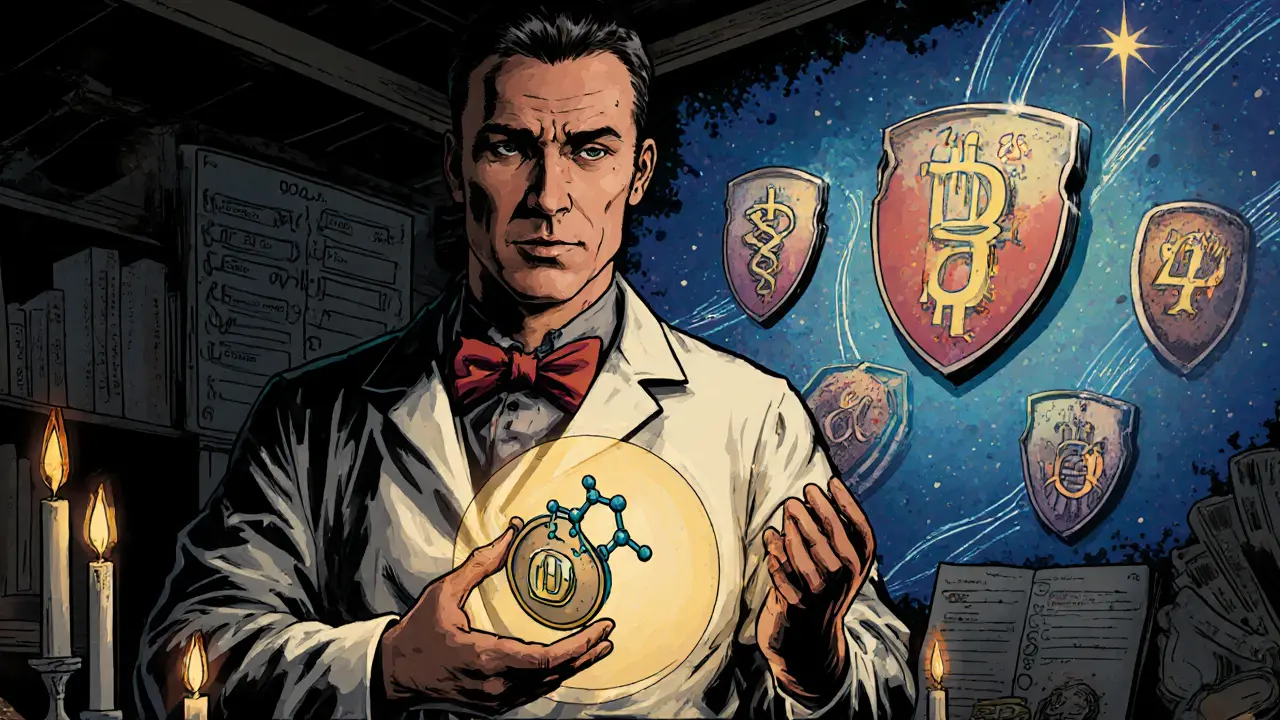BIO Token Value Estimator
Estimate potential BIO token value based on scientific milestones and ecosystem growth. Input your assumptions about research outcomes and market adoption.
The Bio Protocol ecosystem ties token value to real scientific outcomes:
- Current Value $0.0864
- IP Token Potential +30-50% value
- Research Milestone Impact +15-25% value
- Market Adoption +20-30% value
According to the article:
- • 47 active BioDAOs as of September 2025
- • Market cap: $264.86M
- • Expected 15-20% market share by 2027
Most people think crypto is about trading, speculation, or NFTs. But Bio Protocol (BIO) is different. It’s not just another digital coin. It’s a tool to fund real science - specifically, biotech research that traditional funding systems ignore. Imagine backing a cure for a rare disease because you believe in it, not because you expect a quick profit. That’s what BIO makes possible.
What Bio Protocol Actually Does
Bio Protocol, launched in 2024, is a blockchain platform built to fix how science gets funded. Traditional drug development takes over a decade and costs $2-3 billion. Most of that money goes to big pharma, and only projects with huge market potential get funded. That leaves rare diseases, longevity research, and niche health conditions out in the cold.
Bio Protocol changes that. It creates a decentralized network where anyone - patients, scientists, investors - can pool money and vote on which research projects get support. These groups are called BioDAOs. Think of them like community-run labs. One BioDAO might focus on ALS, another on skin aging, another on genetic disorders. Each one is funded and governed by token holders.
The BIO token is the engine behind this. You don’t just buy it to flip it. You use it to vote on research proposals, stake it to earn rewards, and access exclusive research outcomes. If a BioDAO successfully develops a treatment, the intellectual property is turned into IP tokens. These represent fractional ownership, so early supporters can benefit if the treatment becomes commercially viable.
How BIO Works: The Four Core Parts
Bio Protocol isn’t just a token. It’s a system with four working pieces:
- BioDAOs - Community-run research groups focused on specific diseases or biological areas. There are 47 active ones as of September 2025.
- Curation Mechanism - A system that helps the community rank and prioritize research proposals. Not every idea gets funded. Only the most promising ones move forward.
- BIO and Acc Rewards - BIO is for governance and access. Acc tokens are earned by contributing to the ecosystem - like reviewing research, translating documents, or helping with community outreach.
- IP Tokens - When a BioDAO develops a breakthrough, they tokenize the intellectual property. Holders of these tokens get a share of future revenue, like royalties from drug sales.
This structure turns passive investors into active participants. You’re not just buying a coin. You’re joining a movement to reshape how science works.
BIO Token Basics: Supply, Price, and Where to Buy
As of October 24, 2025, the BIO token has a circulating supply of about 1.66 billion out of a total maximum supply of 3.32 billion. That means roughly half the tokens are already in circulation. The market cap sits at $264.86 million, with each BIO trading around $0.0864.
It’s not a high-volume coin like Bitcoin or Ethereum. The 24-hour trading volume is around $20 million - enough for moderate liquidity, but not enough to avoid price swings. The price has ranged between $0.08 and $0.13 over the past week.
You can buy BIO on major exchanges like Binance, Phemex, and KuCoin. To hold or use it in BioDAOs, you’ll need a Web3 wallet like MetaMask. Connect it to the Bio Protocol dApp, swap your ETH or USDT for BIO, and you’re ready to vote, stake, or fund research.
There’s also a second token called Acc, which is used for rewards. You don’t buy Acc - you earn it by helping the ecosystem. This keeps the network active and encourages real participation, not just speculation.

Why Bio Protocol Stands Out in DeSci
Bio Protocol isn’t the only project trying to bring blockchain to science. There’s VitaDAO (focused on longevity), HairDAO (hair loss research), and Ocean Protocol (data sharing). But Bio Protocol is different. It’s the infrastructure layer. Think of it as the operating system, and VitaDAO or HairDAO as apps running on it.
That’s a big deal. Instead of 10 separate DAOs trying to build their own funding tools, they all use the same secure, tested system. This saves time, reduces risk, and makes the whole ecosystem stronger.
The decentralized science (DeSci) sector grew 2,640% in 2024 - way faster than AI. Bio Protocol is one of the top three DeSci projects by market cap, behind only Ocean Protocol and Incentivise. Its backing from Binance Labs gives it serious credibility in the crypto world.
Real Challenges: Is This Too Good to Be True?
It’s easy to get excited. But Bio Protocol isn’t magic. There are real problems.
First, science is hard. Funding isn’t the only barrier. Clinical trials, regulatory approval, lab equipment, peer review - these still need experts. A DAO made of crypto holders can’t replace a seasoned biologist. Critics point out that token-based voting might prioritize flashy ideas over slow, careful science.
Second, regulation is a gray zone. The FDA and EMA don’t have rules for decentralized research. If a BioDAO develops a drug, who’s legally responsible? Can it be sold? These questions are unanswered.
Third, liquidity is low. With only 85,000 unique wallets holding BIO, the market is still small. Big moves can swing the price. If you’re looking for a stable investment, this isn’t it.
Still, the feedback is mostly positive. On CoinMarketCap, BIO has a 4.2/5 rating from over 1,200 users. People love the idea of owning a piece of a future cure. Reddit users call it one of the most practical DeSci projects. And on Trustpilot, users praise transparency in how funds are spent - something traditional research often lacks.

What’s Next? The Roadmap
Bio Protocol isn’t standing still. In October 2025, it launched V2 - a major upgrade that now supports both Ethereum and Solana. That means faster transactions and lower fees. It’s a big step toward making participation easier for regular users.
Partnerships are growing. Harvard Medical School’s Innovation Lab and the Max Planck Institute for Biotechnology have started working with Bio Protocol. That’s huge. It means top-tier scientists are now using the platform, not just crypto enthusiasts.
The long-term goal? To capture 15-20% of the decentralized biotech funding market by 2027. That’s a $2.5-3.5 billion opportunity. If they pull it off, Bio Protocol could change how medicine is developed - forever.
Who Should Care About BIO?
You should pay attention to Bio Protocol if:
- You’re tired of seeing life-saving research stall because it’s not profitable enough.
- You believe science should be open, transparent, and community-driven.
- You want to be part of something bigger than trading charts.
- You have some crypto experience and are willing to learn how DAOs work.
You should avoid it if:
- You want quick profits. BIO is a long-term bet on systemic change.
- You’re uncomfortable with technical setups like wallets and gas fees.
- You expect immediate results. Real science takes years.
Bio Protocol isn’t here to make you rich overnight. It’s here to make science better. And if that sounds like a worthy mission, then BIO might be more than just a coin - it could be your way to help shape the next breakthrough in medicine.
Is Bio Protocol (BIO) a good investment?
BIO isn’t a typical crypto investment. It’s a long-term bet on decentralized science. If you believe in funding rare disease research and want to own a piece of future medical breakthroughs, it’s worth considering. But don’t expect quick gains. The token is volatile, liquidity is limited, and success depends on real-world scientific outcomes - not just market hype.
How do I buy BIO tokens?
You can buy BIO on major exchanges like Binance, Phemex, and KuCoin. You’ll need a Web3 wallet like MetaMask. After buying, transfer your BIO to your wallet and connect it to the Bio Protocol dApp to start voting or funding BioDAOs. Always double-check the contract address: 0xcb1592591996765ec0efc1f92599a19767ee5ffa.
What’s the difference between BIO and Acc tokens?
BIO is the main governance token. You use it to vote on research proposals, join BioDAOs, and access IP tokens. Acc tokens are rewards you earn for contributing to the ecosystem - like reviewing projects, translating content, or helping with community tasks. You can’t buy Acc; you earn it by participating.
Can Bio Protocol really fund real medical research?
Yes - but it’s early. BioDAOs are already funding lab work, clinical trial prep, and data analysis. The big test will come when one of these projects moves into FDA-regulated trials. Partnerships with Harvard and Max Planck suggest serious scientific credibility is being built. The real challenge is proving that decentralized governance can meet the strict standards of medical science.
Is Bio Protocol regulated?
No - not yet. Bio Protocol operates in a legal gray area. While cryptocurrency regulations exist in many countries, there are no clear rules for decentralized biotech research. The FDA and EMA haven’t created frameworks for this model. That’s a risk. But it’s also why the project is so disruptive - it’s pushing the system to adapt.
